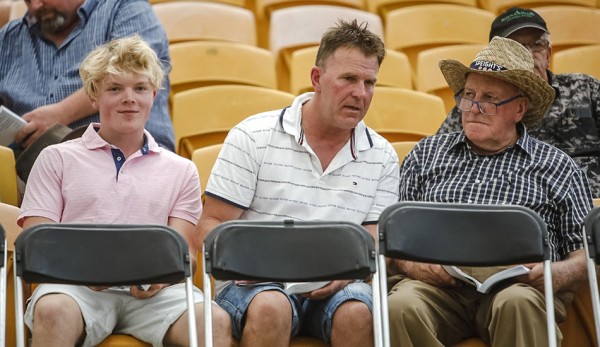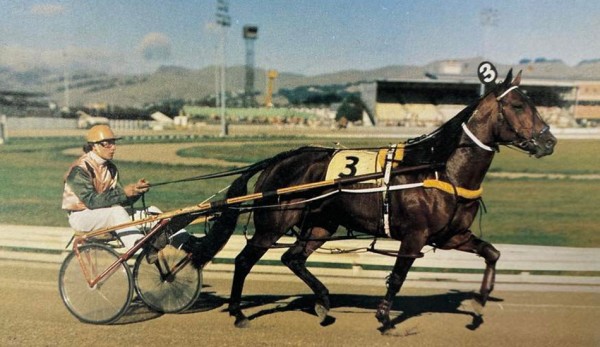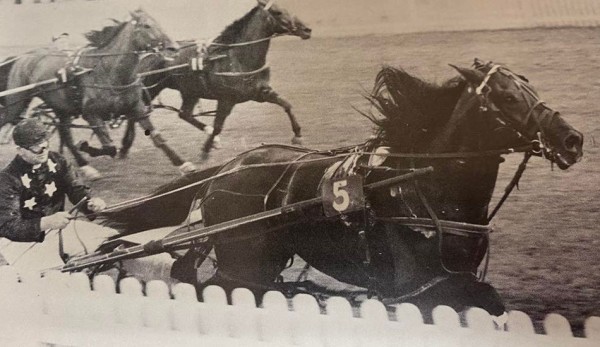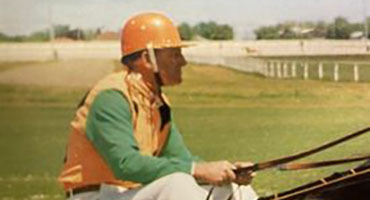By David McCarthy
If you didn’t know him, or know the people who knew him you may be tempted to think the passing of Jim Dalgety was not quite the significant event many of those people believe.
Yes, Jim had two champion stallions in Bachelor Hanover and Out to Win. But quite a few people had already done that.
Yes, if you didn’t know the strike rate you might think his training career was good without being remarkable. He was an astute but not a regular driver and while that he bred horses to win the Great Northern Derby ,the Messenger and the Auckland Cup as well as many G1 filly events was a major achievement, it was hardly unique.
But if tempted by such a conclusion you drastically underrate Jim’s role as an industry “influencer” – as such high achievers are known these days.

There was his impact on the breeding and racing world based on an encylopaedic knowledge of bloodlines, the passion of a lifetime, and an amazing memory. He could recite not only the pedigrees of current and past stars but also add colourful detail of their character and those associated with them. There was the generous advice offered to any breeding student beating a path to his door in search of greater knowledge. There was the high respect hardened professionals had for his horse skills. And of course there was the study, dedication, planning, enterprise, and willingness to forge his own path, to find a new challenge.
However there is another reason why the family is so welcoming of the interested wider public to his funeral next Wednesday at Addington (1 pm.). Jim was an elite performer, happy in his own company but also at ease interacting at all levels of the equine society with a well earned popularity because of it.
Brought up amidst a successful family farming operation in North Otago, with a more educated background than many of his fellow stablehands (he qualified as a woolclasser before starting his racing career) Jim always travelled first class when it came to unravelling the mystery of standardbreds. He had that rare combination of innovation and a deep regard for tradition.
Working for Cecil Devine, Maurice Holmes and Vernon and Stanley Dancer in the US (in that order) might not have been easy but it was the Holy Grail for many would-be horsemen of the era. He observed and absorbed much of their wisdom and in turn he earned their respect and friendship.
His training closely followed the Cecil Devine formula of spending long hours handling and observing his charges. He marvelled that Devine spent so much time with his horses that he knew when they were ready to win without needing to find out via track sectionals. He learned well.
“I got to know Jim when I bought our horses south to race at Addington and we were based there” another notable horseman Mark Purdon recalls.
“I grew to appreciate his great knowledge and especially on the practical side. He knew his horses well and did his horses well, prepared them thoroughly. Nothing was too much trouble. We became good friends. I admired him as a horseman as much as for his knowledge”
Tradition would certainly have played a role in one of most notable achievements, the importing of champion sire Bachelor Hanover. While Bachelor Hanover, bred at Hanover Shoe Farms, had been an outstanding, if well tried, youngster (26 starts at 2) and a hard hitting free-for-aller, his Axworthy sireline was out of fashion in the US and Bachelor Hanover had a double dose of it. He was then standing at a smaller stud up for dispersal at the time Jim bought him in 1964.
Jim knew however that Hal Tryax, also line bred to Axworthy, had been very successful here and Bachelor Hanover’s dam being closely related to Light Brigade could be an appealing proposition in New Zealand. So it proved. He was soon booked out years in advance.
Unlike his predecessor, Goodland, a noted first crop success but a rogue whose days were ended when he ran amuck on the boat returning to New Zealand after a stint in Australia, Bachelor Hanover was a wonderfully natured horse, once the guest in a special box at a Breeders Dinner in Christchurch,as well dressed and relaxed as any of the human guests.
Out to Win, sourced from the Dancers who also bred to him here, was another for tradition being from the Volomite line so successful in New Zealand in earlier eras – and again more recently – but at a time when the Hal Dale line, especially through Adios, was in the ascendancy in America. Out to Win quickly made Jim the owner of two premier stallions within three years, a remarkable feat for a smaller operation. Out to Win later had fertility problems and he was a disappointment as a broodmare sire compared to his “stablemate”.
Jim, a generous student, often paid tribute to John Johnston a North Otago studmaster who had stood the very successful Sandydale in past decades and owned the dam of Cardinal King, for the knowledge he imparted to a young enthusiast on breeding and stud work. He followed that example in his era.

Robert Dunn, closely associated with Out to Win star Bolton Byrd during his time at Lantana Lodge, remembers his time working there with affection and respect.
“I went there really because I wasn’t sure I was going to make it as a driver and I wanted backup from stud work if I had to go into the breeding side. Jim sent me to the Wellington Cup meeting with Dwayne. Derek Jones was to fly up to drive but the airport closed and Jim just said I should drive him. I hadn’t driven much for two years and didn’t even have my gear. We were just beaten the first night by Young Quinn, close the second night and third in the Wellington Cup – a terrific field that year including Robalan”.
“Then I got to drive Bolton Byrd, mainly I think because Maurice Holmes who was very close to Jim had retired, and we won the Derby and later the Auckland Cup. Drives were hard to get for young guys then and the faith he showed in me was a turning point. In all the time I worked there we never had an argument. A great boss.”
Robert gave an example of Jim’s famed photographic memory and his flair for trying something different.
“We had around 200 mares on the farm when Bachelor and Out To Win were going and mainly just four of us, Jim, (his wife) Faye, a fine horsewoman and successful breeder in her own right, Tim Musson and me. The mares and foals never had tags on them. Jim knew every one. I remember him one day telling me a foal I was handling wasn’t with the right mare and we had better fix it. I couldn’t believe how he would know that.”
Bolton Byrd tied up badly and had a gait problem.
“Jim took him off oats and fed him dried peas with the other usual feed. Then he took a risk I thought, allowing an Australian friend try something really different with the shoeing. Yet those two decisions made the horse what he was”
Mike De Filippi, who drove Happy Hazel in some of her early successes, spoke highly of both the filly and her trainer.
“I always enjoyed driving for Jim. He left it to you and was never critical after a race. He understood race driving. I drove some top fillies (Bionic Chance, Take Care) and Happy Hazel was right up there” he recalls of only the third filly to reach open class as a three year old.
Peter Yeatman, who took Jim’s place at the Devine stable and later worked for him at Blakes Rd and West Melton (“Peter comes in the dark and goes home in the dark” was a Dalgety quote), also rated him a top employer and a man dedicated to his interests – though it wasn’t always plain sailing.
“Jim was always thinking or working but the routine could suffer. Sometimes when we could have brought the horses in we were delayed while he was on a project. He could look up something in the Stud Book at lunch time and an hour or more could pass. He was always friendly and I never saw him lose his temper. A bit of a character but he helped a lot of people and didn’t talk about it. We were leading the premiership half way through the season with 26 winners at West Melton but we ran out of race horses in the autumn. That was quite a feat then.”
Peter set up training after Jim retired from it and inherited his first winner, Local Star, from the stable which set him on his way. Jim was good at setting people up for careers. Jim had also raced the flashy Golden Slipper-winning two year old Rossini which Maurice Holmes sold to Australia at that age. Jim loved his horses but was also a realist and a seller as you needed to be. There were a host of other good performers in just a few years training on a larger scale. Too many to mention.
His success with mare selection has been equalled by few. The best known example was buying Bellajilly when she was battling in claimers in the US and with 80 starts on the clock. Jim, using the US contacts he had made on his trips, bided his time, bred her to Most Happy Fella and brought them home with the usual 6 months quarantine wait in the UK.

While he would have known that the family was a noted producer of fillies going back to a pony mare of the 1920’s Krina he was also swayed that she was by Van Dieman (pictured). Sire and filly had been at the Devine property in his time there. Bellajilly, from the ponified Malabella, won the NZ Derby and Jim exercised Van Dieman by riding him because it wasn’t safe to do it any other way. Van Dieman may have been a mixed success at stud but was a potent cross with this family, also leaving Vanadium and Van Glory.
“Jovial Jeanie, the Most Happy Fella foal, got hurt somewhere on the way out, had a dropped hip and could only reach top pace right handed. Jim sent her up to Roy and Barry (Purdon). I think she won 9 in a row in Auckland,” Robert Dunn recalled.
Her foal Happy Hazel was “just a class above them” as a three year old, according to main driver Mark Purdon. The only disappointment was being unluckily beaten in the NZ Oaks adding to the jinx in that race for generations of the top filly descendants of Krina. It did not end until 2019 when Princess Tiffany won, trained by Mark, driven by partner Natalie.
Jim’s search for likely sorts from our traditional families continued with leasing of Petulus and her half-sister Wrack’s Gold, daughters of the first NZ Oaks winner Perpetua from Oamaru’s Andy Todd and close family the Ormandys, both of whom Jim knew well.
Petulus (Stormyway), from the No 1 Pride of Lincoln family, left high class filly and mare Golden Oriole to a Dalgety favourite, Local Light. Golden Oriole ended up beating all the stars of her time, colts included, and was later sold to the US for a then sensational 20,000 pounds by 17 year old Murray Butt who had leased and later bought her from Jim. She had been difficult in the education process and time was an issue with stud and racing commitments.
“Wes Butt came around one day saying he was looking to continue a family tradition of presenting a horse to his boys on turning 18 and asking if there was anything going. Jim said he wasn’t sure about the filly but he would lease it with a fairly low right to purchase for them to try.” Peter Yeatman recalled.
“He accepted those sort of things. He was never mean spirited about others’ success. He was satisfied he had played a role”
Wrack’s Gold, by Local Light (and later sold to Australia for a record price for a broodmare) left Nikellora the dam of Bolton Byrd and Melton Monarch, both by Out to Win from the Bachelor Hanover mare and Jim’s best age group performers.
North Otago was the Dalgety gift that kept on giving. Jim’s father, also Jim, besides being a prominent farmer, a successful owner and breeder at Kakanui, gave his son his first training success with Vanity Scott at Forbury Park in 1959.
However Jim has been somewhat short changed over the credit for breeding broodmare superstar Scuse Me, officially credited to Mark Purdon, who confesses he doesn’t know how that happened.
“I had the mother Super Smooth, a beautiful mare but without much speed. Jim loved her and wanted to try her again and when that didn’t work out wanted to breed from her and we would race the progeny.” Mark recalls.
“He had B G’s Bunny at stud then and Scuse Me was the foal. It was really all Jim’s doing. The plan was to sell the foal but Jim rang and said she wouldn’t bring a big price, he really liked her and could we race her in partnership which we did,” Mark said of the great broodmare.
NZ Cup winners Just an Excuse and Kyms Girl were among other stars Jim had a hand in breeding. And his stallion Farm Timer (sourced from the Dancers) left a special animal in Blossom Lady.

Jim rather abruptly gave up public training in the mid 1960’s after moving to West Melton from the historic (that word again) Blakes Rd stable opposite Don Nyhan’s Globe Lodge, where the mighty Harold Logan had once been trained. Jack Smolenski followed him. It was almost an overnight decision according to knowledgeable memories. He decided to concentrate on the stud, his cattle, a small team and as a buying agent for Stanley Dancer, famous here for training Cardigan Bay but a legend in US harness.
On one trip to the US (1967) Jim posted a win there himself at Freehold Raceway with Lyndhurst, a purchase from Ted Lowe. He had notable success as an agent including the purchase of Cardinal King which swept the International Series at Yonkers in 1968 and that earned the respect of several prominent Americans. There is a long list of other performers purchased and bred, again too many to mention.
Jim’s well-known experiment of crossing thoroughbred mares with his stallions in a bid to re-energise the standardbred was triggered by friend Jack Litten’s comment that inbreeding would lead to its extinction, something the Dancers also believed. It was another bold innovation but with a frustrating ending. History held that such an outcross had worked in the past and also more recently, with Angelo Dundee and especially Kata Hoiho, a top performer for Peter Yeatman. It needed five generations to evaluate the success of the mission and Jim gave up after four. Not from lack of belief. He was defeated by nature.
“We got too many colts. We wanted fillies. Made it very difficult” he said. He had two fillies in the first year, one from Carron, granddam later of high class thoroughbred Polly Porter, but the dominance of colts virtually ended the project.

He started again more recently this time re-establishing the Arab influence prevalent in early trotting years in New Zealand and now with some current success from the stable of son Cran whose own great success is a notable third leg of a 4 generation harness dynasty with the emergence of grandson Carter. The continuation of the family tradition meant a lot to Jim.
He had more success with thoroughbreds on the track. A notable winner was Maxwelton, raced with well known thoroughbred breeder Joyce Edgar-Jones (Sailing Home) who streeted a field at Riccarton in 1970 at 82/1.
He was certainly astute enough to use his knowledge and reputation as a marketing tool and a powerful one it was. But unlike some breeders intent on protecting their own Jim brought an intellectual discipline to his observations. He was quick to acknowledge no matter how much you know there are even fewer certainties in the breeding barn than on the racetrack.
An example was Alberton. Jim was so disappointed with his stud performance (apart from Happy Hazel) that he said he never claimed the insurance when the horse died prematurely.
“I had persuaded so many of my friends to come to him I was just embarrassed with the results. It would have felt wrong for me to make any more money out of it”
Late in life he perhaps surprisingly rated the Auckland-owned Mister Chips when it came to the best he had handled. He took Mister Chips to NZ Cup class in the late 1960’s with a string of victories against the best in the business yet several other good trainers struggled to win a race with him.
“He was sent down to me from the north. He was like a thoroughbred and I trained him like a thoroughbred, cut out a lot of the slow work. Alf Bourne and other top trainers had a go later when he changed hands but he wasn’t the same horse. Couldn’t take the work most others could.”
Peter Yeatman agreed.
“I took him up to Auckland for Jim and I drove him in a lot of his work. He was a terrific horse, won them in a row. The only one who could foot it with him at home was a horse called Fielder and he would have been a Cup contender here. He was raced by Jim’s Dad and went to America with one of the teams”
In more recent years Jim’s harness profile receded somewhat as he turned his attention more to his farming and land interests having achieved much of what he wanted with horses. As with the family farm at Kakanui every post was painted white, often by Jim himself when required. Being particular was in the Dalgety DNA. But his enthusiasm for racing and breeding never flagged.
Jim’s cattle brought top prices at auction and he had a growing and successful interest in sheep. It would be fair to say he also felt some of the “people factor” had gone out of the breeding industry as increased commercialisation meant fewer hobby breeders and lesser interaction with them. Interaction with clients was his lifeblood. A stroke some time ago was a setback that didn’t daunt him. He was soon back in action, the prodigious memory affected, the spirit undimmed. Indomitable until the end.
James Scott Dalgety just seemed an essential part of the harness landscape. A star in reverse. He had walked the walk and people loved listening to him talking the talk. He had absorbed and remembered all he had learned and there was always an audience who appreciated that along with the words the deeds had been done.
“Me old mate” was his catch phrase, yet more than that. A signature tune.
One that knowledgeable people in harness racing will be singing for many many years to come.

 USA
USA Canada
Canada Australia
Australia New Zealand
New Zealand Europe
Europe UK / IRE
UK / IRE



